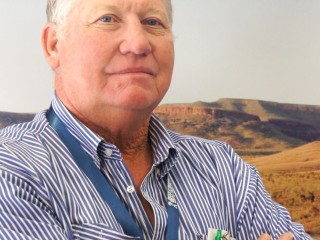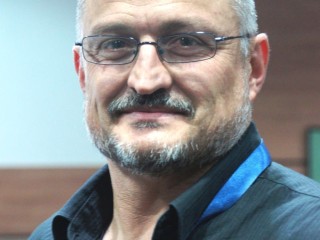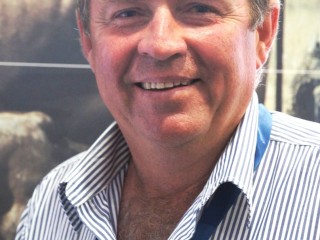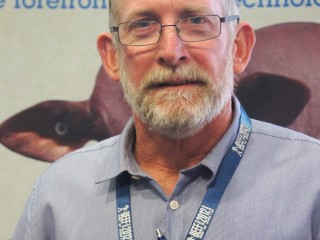Australia can be proud of its world-class beef research and development programs, often carried out under tight budget constraints. But outcomes mean little if they are not rapidly and widely adopted by commercial industry stakeholders.
More than 300 researchers, extension practitioners, funders and beef producers gathered in Darwin last week for the North Australian Beef Research Council’s Northern R&D conference.
The adoption challenge was a frequent topic of discussion, both within and outside the conference hall. Beef Central was there, asking stakeholders what the impediments were to greater uptake of new technologies among commercial producers.
A number of respondents raised the power of ‘seeing is believing.’ Clear visual evidence of the use of genetically superior bulls in weight in calves compared with controls bred from low EBV bulls could provide a more powerful message than simply viewing numbers on a page, for example. For this reason the ‘tried and tested’ Producer Demonstration Site activity is again gathering popular support.
Here’s a sample of stakeholder responses to the adoption challenge …
Dan Lynch, beef producer, Tara, Cloncurry, Qld:
 “Stimulating uptake of new technologies has been a big issue for years, but the biggest problem is that at the extension/education level, it is being delivered in small, isolated sections that often influence just one part of the business. It lacks the big picture, and I believe that any advance in the cattle business has to be looked-at from a holistic perspective. There is little point in investing in nutrition if the genetics in the herd is not up to scratch. That’s one reason why the uptake has not been as strong or as rapid as some might have wished. There’s lots of good research outcomes out there, but somehow we need to get it to producers in a holistic package, that they can adopt over time. The traditional extension role may be one way to deliver it, but also, producers need to be better informed that the way things have always been done is not sustainable, and that embracing technology is becoming critical to their survival. Don’t be fearful of it, because of they don’t engage, they will fall through the cracks. We need to embrace technology in the big sense – even the way-out blue-sky projects like virtual fencing and unmanned vehicles should not be dismissed. Fundamentals like female reproduction will always remain vitally important to the northern industry, but we also need to look 10-15 years ahead at what else is coming down the pipeline.”
“Stimulating uptake of new technologies has been a big issue for years, but the biggest problem is that at the extension/education level, it is being delivered in small, isolated sections that often influence just one part of the business. It lacks the big picture, and I believe that any advance in the cattle business has to be looked-at from a holistic perspective. There is little point in investing in nutrition if the genetics in the herd is not up to scratch. That’s one reason why the uptake has not been as strong or as rapid as some might have wished. There’s lots of good research outcomes out there, but somehow we need to get it to producers in a holistic package, that they can adopt over time. The traditional extension role may be one way to deliver it, but also, producers need to be better informed that the way things have always been done is not sustainable, and that embracing technology is becoming critical to their survival. Don’t be fearful of it, because of they don’t engage, they will fall through the cracks. We need to embrace technology in the big sense – even the way-out blue-sky projects like virtual fencing and unmanned vehicles should not be dismissed. Fundamentals like female reproduction will always remain vitally important to the northern industry, but we also need to look 10-15 years ahead at what else is coming down the pipeline.”
Dave Johnston, research scientist, Animal Genetics & Breeding Unit, UNE Armidale, NSW:
 “In my field of animal genetics, what we’re observing is that the signals that drive the commercial producer’s profit are not getting fed back through to where the genetic recording is happening in tropically-adapted breed seedstock herds. That’s primarily happening because in order to generate enough bulls, there is the ‘multiplier’ bull breeder tier which to a large extent is not performance recording or keeping pedigrees. So there is a lack of clear signals coming back to the seedstock guys about exactly what is driving profitability at commercial level. So how do we cultivate those signals? We can do it two ways: the first is via ‘push through’ in making sure that the bulls going into those multiplier herds are as genetically superior as possible, so there is less dilution occurring; and secondly engaging more of those multiplier herds in some level of recording. Perhaps the available DNA technology is an avenue, without the need to performance record, under those circumstances.”
“In my field of animal genetics, what we’re observing is that the signals that drive the commercial producer’s profit are not getting fed back through to where the genetic recording is happening in tropically-adapted breed seedstock herds. That’s primarily happening because in order to generate enough bulls, there is the ‘multiplier’ bull breeder tier which to a large extent is not performance recording or keeping pedigrees. So there is a lack of clear signals coming back to the seedstock guys about exactly what is driving profitability at commercial level. So how do we cultivate those signals? We can do it two ways: the first is via ‘push through’ in making sure that the bulls going into those multiplier herds are as genetically superior as possible, so there is less dilution occurring; and secondly engaging more of those multiplier herds in some level of recording. Perhaps the available DNA technology is an avenue, without the need to performance record, under those circumstances.”
Chris Nott, beef producer, Alcoota, Alice Springs, NT:
 “Given the advances in email and internet, isolation and lack of communication is no longer an excuse for poor R&D adoption rates in Central Australia. Nor is the standard of country around Alice Springs, which is good enough to produce cattle for a wide variety of premium markets. The only problem is the transport distance. But there has been a general change in the mood towards adoption of new tools developed for industry – there are producers in the region that are right at the edge of new technologies applicable in extensive areas. Walk-over automated weighing and drafting was started in the Alice Springs district, and current work is focussing on extending the window for MSA through long-distance transport. But there’s still a gap, and we need to find ways to attract more uptake. It’s not that the information isn’t there, but challenges like labour constraints can make it difficult to find time to devote to working on business improvements. Often, the on-farm Producer Demonstration Site is the best vehicle to get a message across on R&D outcomes, and we need to promote more of this style of message delivery.”
“Given the advances in email and internet, isolation and lack of communication is no longer an excuse for poor R&D adoption rates in Central Australia. Nor is the standard of country around Alice Springs, which is good enough to produce cattle for a wide variety of premium markets. The only problem is the transport distance. But there has been a general change in the mood towards adoption of new tools developed for industry – there are producers in the region that are right at the edge of new technologies applicable in extensive areas. Walk-over automated weighing and drafting was started in the Alice Springs district, and current work is focussing on extending the window for MSA through long-distance transport. But there’s still a gap, and we need to find ways to attract more uptake. It’s not that the information isn’t there, but challenges like labour constraints can make it difficult to find time to devote to working on business improvements. Often, the on-farm Producer Demonstration Site is the best vehicle to get a message across on R&D outcomes, and we need to promote more of this style of message delivery.”
Steve Petty, industry consultant, Northern Development Co, Kununurra, WA:
 “There are good reasons why the rate of uptake is perhaps not as strong in the northern cattle region than others. In some cases the technologies are not user-ready, and it is in this area that there is scope for greater focus. When I joined Heytesbury Pastoral Co years ago I thought I had all the answers, and arrived with a bag full of tricks. I quickly realised that very little of that technology that I thought as a former researcher was directly applicable to commercial operations was ready. In many cases the research is done, the concept is proven, but there is something missing in between in turning it into a useful system for industry adoption. A simple process like early weaning is a good example. The R&D was done and it was proven to work, but it failed to provide answers about how to feed the calves, how cost-effective it was under different applications, and how the principles could be scaled-up to much bigger operations. I don’t think we, as an industry, have been effective enough in that. Distinguishing between which technology area to adopt is another challenge. There’s a plethora of technologies available out there now. Which is the most important? Which will give the best return on investment? There is a clear extension need in helping producers distinguish what is best for their own set of circumstances, and as a consultant one of my growing roles is in interpretation of research and bringing the two together, by making informed choices.”
“There are good reasons why the rate of uptake is perhaps not as strong in the northern cattle region than others. In some cases the technologies are not user-ready, and it is in this area that there is scope for greater focus. When I joined Heytesbury Pastoral Co years ago I thought I had all the answers, and arrived with a bag full of tricks. I quickly realised that very little of that technology that I thought as a former researcher was directly applicable to commercial operations was ready. In many cases the research is done, the concept is proven, but there is something missing in between in turning it into a useful system for industry adoption. A simple process like early weaning is a good example. The R&D was done and it was proven to work, but it failed to provide answers about how to feed the calves, how cost-effective it was under different applications, and how the principles could be scaled-up to much bigger operations. I don’t think we, as an industry, have been effective enough in that. Distinguishing between which technology area to adopt is another challenge. There’s a plethora of technologies available out there now. Which is the most important? Which will give the best return on investment? There is a clear extension need in helping producers distinguish what is best for their own set of circumstances, and as a consultant one of my growing roles is in interpretation of research and bringing the two together, by making informed choices.”
Paul Zlotkowski, beef producer, Woolagorang, Burketown, Gulf Country, QLD:
 “It’s difficult on a large scale operation and in country where fences can get washed away every couple of years to adopt some of these new technologies, particularly in closer herd management. On our place, about 900,000ha, it’s a matter of trying to pick a few key targets, but the key factor is whether it is profitable. One of the conference speakers was advising people under some circumstances to wind-back supplementation strategies, to improve net return. We drew the same conclusion a few years ago.”
“It’s difficult on a large scale operation and in country where fences can get washed away every couple of years to adopt some of these new technologies, particularly in closer herd management. On our place, about 900,000ha, it’s a matter of trying to pick a few key targets, but the key factor is whether it is profitable. One of the conference speakers was advising people under some circumstances to wind-back supplementation strategies, to improve net return. We drew the same conclusion a few years ago.”
Roger Landsberg, beef producer, Trafalgar, Charters Towers, QLD:
 “It’s always been a challenge to industry. The real entrepreneurs and innovators will always go looking for it and find it. The middle ones will watch what they do, before adoption, and I don’t know what we do with the last 10 or 15 percent. But increasing Government regulation is not going to solve the problem – regulation in the form of another layer of government as ‘form tickers’ is happening at the expense of extension. Unfortunately there is an increasingly small pool of experienced State Government extension officers and they are all closing in on retirement. There are a few younger ones being put on, but they are all on two to five year contracts. By the time they are mentored by the older ones, and become useful, their contract runs out. The private sector is partially filling that extension gap, but we still have the mentality in the industry that they don’t want to pay for it, because they can’t see much value in it, and don’t believe they need it. The web can play an important role, in finding and accessing information quickly, but the producers we need to get to in terms of improving management and land use are often not yet big web users, and respond to people. But Governments aren’t big on one-to one.”
“It’s always been a challenge to industry. The real entrepreneurs and innovators will always go looking for it and find it. The middle ones will watch what they do, before adoption, and I don’t know what we do with the last 10 or 15 percent. But increasing Government regulation is not going to solve the problem – regulation in the form of another layer of government as ‘form tickers’ is happening at the expense of extension. Unfortunately there is an increasingly small pool of experienced State Government extension officers and they are all closing in on retirement. There are a few younger ones being put on, but they are all on two to five year contracts. By the time they are mentored by the older ones, and become useful, their contract runs out. The private sector is partially filling that extension gap, but we still have the mentality in the industry that they don’t want to pay for it, because they can’t see much value in it, and don’t believe they need it. The web can play an important role, in finding and accessing information quickly, but the producers we need to get to in terms of improving management and land use are often not yet big web users, and respond to people. But Governments aren’t big on one-to one.”
